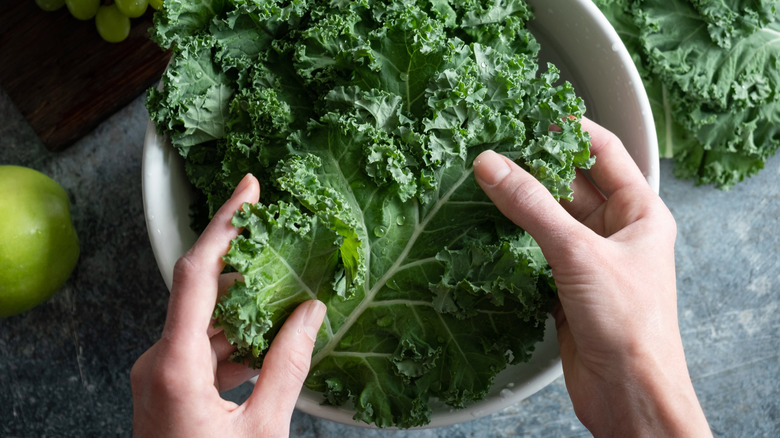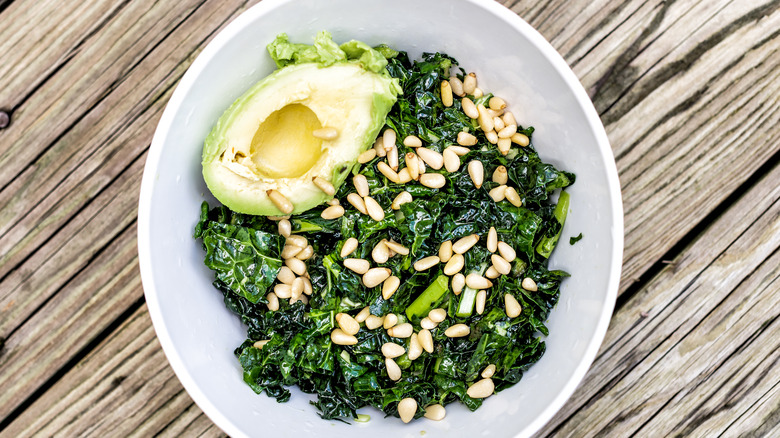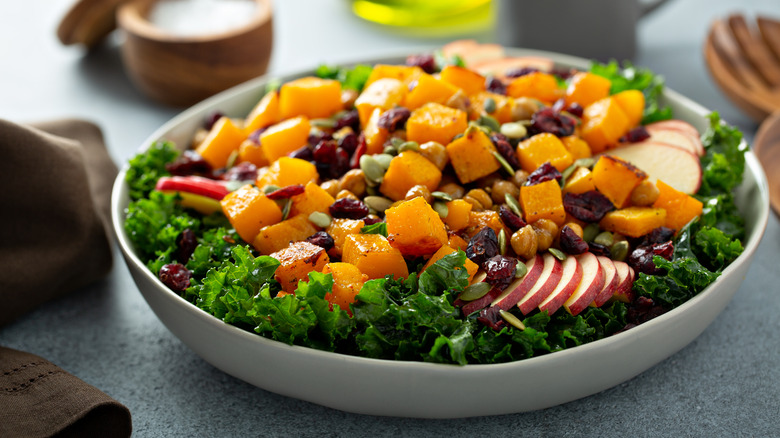Treat Your Next Kale Salad To An Avocado Massage
Kale is a popular leafy green not only for its versatility but also for its nutritional benefits. It's particularly high in beta-carotene as well as vitamins C and K. When you cook it though, it loses some of its nutrients – so by eating it in its raw form, you can get the most of its benefits. There are those who do not like it raw unfortunately — whether because of its chewy, fibrous texture, or because of its somewhat bitter and very plant-like flavor.
There is a way to get around these issues that both preserves the vegetable's nutrients and can fix the bitter taste in kale. This can be achieved by massaging it along with the aid of fatty or acidic ingredients. This hands-on technique breaks down the plant's cell walls, making it less fibrous, more pleasant to eat, and easier to digest.
Olive oil (a fat) or lemon juice (an acid) are often what's used to give kale a good rub down. However, another trick you can use for similar results is to massage your kale with avocado. This effectively softens the leaves while simultaneously creating the start of a tasty salad dressing. According to the American Heart Association, the monounsaturated fats in avocados can decrease one's risk of heart disease. They also work wonders for transforming kale from something hard to swallow into a dish you won't want to stop eating.
The avocado kale massage trick that makes instant salad dressing
Massaging kale with avocados is a really simple way to tenderize kale. You'll be using your hands for this, so wash them first, then wash and dry the kale. You may wish to remove the tough stems before proceeding, which is easily done by using Martha Stewart's kale stripping spoon hack. You can save the stems for another purpose ... toss them into a stir-fry with other veggies or throw them into a blender to bulk up a green smoothie.
Chop or tear your kale into bite-sized pieces and place them in a large bowl. Using enough avocado to liberally coat the pieces, add chunks of it to the bowl, then get right in there with your hands and start mashing and rubbing the avocado into the kale. The idea is to literally massage the leaves with the creamy substance to really get it worked in. Continue mixing, rubbing, and smushing it all together until you feel the kale's texture change — after a couple of minutes, it will relax as the avocado starts to temper it. Once it reaches this stage, you can stop massaging, as too much loss of structure can turn it to mush.
To complete the dressing, add a squeeze of lemon, a dash of salt and pepper, and optionally, some olive oil, a touch of maple syrup, and Dijon mustard for more flavor. Get creative and mix any flavors you enjoy with avocado.
More fats you can use to tenderize kale
This massaging method works best with firm varieties such as curly kale, or lacinato, also known as Tuscan or dinosaur kale. Baby kale, on the other hand, usually does not require this sort of handling, as the young leaves are naturally more tender than mature kale.
Other fats can be used to massage and soften kale other than avocado too. Olive oil is most common, often along with lemon and salt, which provides a one-two punch of both fat and acid. Alternately, other oils will work as well — like avocado oil, flaxseed, or walnut — all of which are rich in omega-3 fatty acids that are essential for cell function and hormone regulation — and only available from certain foods (per Harvard School of Public Health).
Instead of oil, you can also use other fats like tahini, which is made from sesame seeds, or nut butters like peanut or almond, all of which work to mellow your kale as well as form delicious dressings. To save yourself a step, you could even use the dressing to massage your kale.
Eat the salad as-is for your daily dose of greens or make it more of a meal by adding proteins, such as grilled tofu or chicken, along with your favorite salad ingredients. Kale goes great with additions like feta cheese, roasted vegetables like sweet potatoes and beets, chopped apples, pomegranate seeds, dried cranberries, toasted almonds, pine nuts, or crispy chickpeas.



